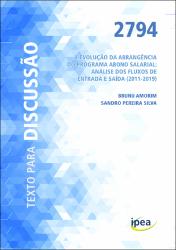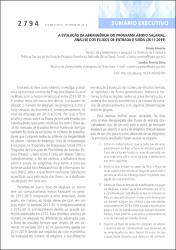Please use this identifier to cite or link to this item:
https://repositorio.ipea.gov.br/handle/11058/11455Full metadata record
| DC Field | Value | Language |
|---|---|---|
| dc.contributor.author | Amorim, Brunu Marcus Ferreira | - |
| dc.contributor.author | Silva, Sandro Pereira | - |
| dc.coverage.spatial | Brasil | pt_BR |
| dc.coverage.temporal | 2011-2019 | pt_BR |
| dc.date.accessioned | 2022-09-15T18:50:28Z | - |
| dc.date.available | 2022-09-15T18:50:28Z | - |
| dc.date.issued | 2022-09 | - |
| dc.identifier.uri | http://repositorio.ipea.gov.br/handle/11058/11455 | - |
| dc.description.abstract | Este estudo teve como objetivo investigar a dinâmica operacional recente do Programa Abono Salarial no Brasil, com o horizonte temporal entre 2011-2019. A análise levou em conta ocorrências que podem ter afetado o número de elegíveis ao programa, como a forte retração da economia e, consequentemente, do nível de emprego em 2015 e 2016. Por isso, o foco analítico recaiu sobre os fluxos de entrada e saída dos trabalhadores, buscando relativizá-los com os fluxos gerais do mercado de trabalho formal. A principal fonte de dados foi a Relação Anual de Informações Sociais (Rais), sobre a qual foram realizadas tabulações específicas para estimação dos fluxos de trabalhadores elegíveis em cada ano. Algumas das principais conclusões foram: i) o movimento da ocupação formal foi um fator fundamental para o crescimento do número de elegíveis entre 2011 e 2019, com efeito maior para quem estava entrando ou saindo da Rais; ii) os grupos de trabalhadores que conseguiram mais acesso ao mercado formal tiveram um aumento relativo do total de elegíveis; iii) a dinâmica do número de trabalhadores que se tornaram elegíveis entre aqueles que já possuíam emprego formal de um ano para o outro apresentou diferenças quanto ao cumprimento dos critérios, com destaque para o critério de tempo; e iv) a política de salário mínimo tem influência no número de elegíveis ao abono, principalmente pela influência sobre o critério da remuneração. | pt_BR |
| dc.language.iso | pt-BR | pt_BR |
| dc.publisher | Instituto de Pesquisa Econômica Aplicada (Ipea) | pt_BR |
| dc.title | A Evolução da abrangência do Programa Abono Salarial : análise dos fluxos de entrada e saída (2011-2019) | pt_BR |
| dc.title.alternative | Texto para Discussão (TD) 2794 : A Evolução da abrangência do Programa Abono Salarial : análise dos fluxos de entrada e saída (2011-2019) | pt_BR |
| dc.type | Texto para Discussão (TD) | pt_BR |
| dc.rights.holder | Instituto de Pesquisa Econômica Aplicada (Ipea) | pt_BR |
| dc.source.urlsource | http://www.ipea.gov.br | pt_BR |
| dc.location.country | BR | pt_BR |
| dc.description.physical | 36 p. : il. | pt_BR |
| dc.subject.vcipea | IPEA::Trabalho::Salários. Incentivos Salariais::Salários. Incentivos Salariais | pt_BR |
| dc.subject.vcipea | IPEA::Quadro Institucional::Governo. Administração Pública::Estado::Programas Governamentais | pt_BR |
| dc.subject.vcipea | IPEA::Política Econômica. Política Social. Planejamento::Seguridade Social | pt_BR |
| dc.subject.vcipea | IPEA::Trabalho::Recursos Humanos::Emprego::Política de Emprego | pt_BR |
| dc.rights.license | É permitida a reprodução deste texto e dos dados nele contidos, desde que citada a fonte. Reproduções para fins comerciais são proibidas. | pt_BR |
| dc.subject.keyword | Políticas de emprego e renda | pt_BR |
| dc.subject.keyword | Programa Abono Salarial | pt_BR |
| dc.subject.keyword | Mercado de trabalho | pt_BR |
| dc.subject.keyword | Seguridade social | pt_BR |
| ipea.description.additionalinformation | Série monográfica: Texto para Discussão : 2794 | pt_BR |
| ipea.description.additionalinformation | Possui referências bibliográficas | pt_BR |
| ipea.access.type | Acesso Aberto | pt_BR |
| ipea.rights.type | Licença Comum | pt_BR |
| ipea.englishdescription.abstract | This study aimed to investigate the recent operational dynamics of the Abono Salarial Program in Brazil, with a time horizon between 2011-2019. The analysis took into account occurrences that may have affected the number of people eligible for the program, such as, for example, the strong retraction of the economy and, consequently, of the level of employment in 2015 and 2016. Therefore, the analytical focus fell on the inflows and outflows of workers, seeking to relativize them with the general flows of the formal labor market. The main data source was the Annual Report of Social Information (Rais), on which specific tabulations were performed to estimate the flows of eligible workers in each year. Some of the main conclusions: i) the movement of formal occupation was a fundamental factor for the growth in the number of eligible people between 2011 and 2019, with its greatest effect for those who were joining or leaving Rais; ii) the groups of workers that gained more access to the formal market had a relative increase in the total number of eligible workers; iii) the dynamics of the number of workers who became eligible among those who already had a formal job from one year to the next showed differences in terms of compliance with the criteria, with emphasis on the time criterion; and iv) the minimum wage policy has an influence on the number of people eligible for the Abono Salarial, mainly due to its influence on the remuneration criterion. | pt_BR |
| ipea.researchfields | N/A | pt_BR |
| ipea.classification | Administração Pública. Governo. Estado | pt_BR |
| ipea.classification | Emprego. Trabalho | pt_BR |
| Appears in Collections: | Emprego. Trabalho: Livros | |
Files in This Item:
| File | Description | Size | Format | |
|---|---|---|---|---|
| td_2794_web.pdf | 1.34 MB | Adobe PDF |  View/Open | |
| td_2794_sumex.pdf | 164.11 kB | Adobe PDF |  View/Open |
Items in DSpace are protected by copyright, with all rights reserved, unless otherwise indicated.

